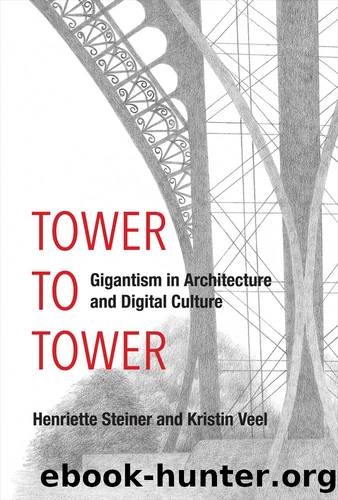Tower to Tower by Henriette Steiner & Kristin Veel

Author:Henriette Steiner & Kristin Veel [Steiner, Henriette & Veel, Kristin]
Language: eng
Format: epub
The Womb as Time Machine
Both the bomb that exploded in the Twin Towers’ parking garage in 1993 and the plane attacks of 2001 have been interpreted as motivated in part by a desire to achieve the spectacular.13 The fear of whether an attack would happen again has left its mark on the building’s design and construction. This intense preoccupation with security can be read as an expression of hardline and even militant masculinity, which in the previous chapter we identify as characterizing the discourse around September 11. But a closer view reveals that its vocabulary of security is in fact a subtle engagement with the intricacies of the imagery of the container: the act of building on a gigantic scale at this site carries with it a stubborn sense of defiance, which has resulted in the building’s resemblance to a gigantic bunker clad in glass. This is a form of material excess, a gigantism that literally thickens in the construction itself, not in a way that is hidden from view but in a way that is visible only if you look closely. From a distance, for example, the lower floors seem open and transparent because of vertical glass panels that stick out like fins. However, on closer inspection, these panels turn out to be decorative elements that hide from view a concrete construction so thick and seemingly impenetrable that it would withstand attacks from ground level by lorries or tanks.
The lower six levels of One World Trade Center also contribute to the building’s securitization because they are mechanical floors and house no office space. Visitors and office workers enter through large doors from different sides and move up the building. The same aesthetic connotations apply to the vertical openings that penetrate the facade higher up. These openings are vents that can be used to let out poisonous air from inside the building in case of a chemical attack. The building thus fences itself off from the world and makes a virtue of its fear-driven aesthetics. Yet rather than being buried in the ground like most bunkers, One World Trade Center exhibits impenetrability and anonymity almost demonstratively. Turning its own container qualities into a defensive tool, the building seems to wait for an onslaught—anticipating and guarding against a future narrative of material inadequacy. As an imprint of the new metropolitan mainstream, the building’s response to the possibility of an attack is not to hide but rather to protrude. It is not just visible: it is visually unavoidable—a securitized womb of gigantic proportions that, as becomes apparent when one enters the building, makes use of temporal conflation on multiple levels in the mediatized view that it offers. This paradoxicality—a blend of narcissistic grandiosity and Teflon-like mainstream anonymity—gives the building the oxymoronic quality of both gigantism and latency.
As with most of the commercial skyscrapers on Manhattan (apart from those named after the corporations residing in them), it is necessary to know which companies are based here in order to find them. Their location
Download
This site does not store any files on its server. We only index and link to content provided by other sites. Please contact the content providers to delete copyright contents if any and email us, we'll remove relevant links or contents immediately.
| Automotive | Engineering |
| Transportation |
Whiskies Galore by Ian Buxton(41528)
Introduction to Aircraft Design (Cambridge Aerospace Series) by John P. Fielding(32888)
Small Unmanned Fixed-wing Aircraft Design by Andrew J. Keane Andras Sobester James P. Scanlan & András Sóbester & James P. Scanlan(32573)
Craft Beer for the Homebrewer by Michael Agnew(17932)
Turbulence by E. J. Noyes(7700)
The Complete Stick Figure Physics Tutorials by Allen Sarah(7137)
Kaplan MCAT General Chemistry Review by Kaplan(6595)
The Thirst by Nesbo Jo(6435)
Bad Blood by John Carreyrou(6274)
Modelling of Convective Heat and Mass Transfer in Rotating Flows by Igor V. Shevchuk(6222)
Learning SQL by Alan Beaulieu(6035)
Weapons of Math Destruction by Cathy O'Neil(5827)
Man-made Catastrophes and Risk Information Concealment by Dmitry Chernov & Didier Sornette(5645)
Digital Minimalism by Cal Newport;(5389)
Life 3.0: Being Human in the Age of Artificial Intelligence by Tegmark Max(5184)
iGen by Jean M. Twenge(5161)
Secrets of Antigravity Propulsion: Tesla, UFOs, and Classified Aerospace Technology by Ph.D. Paul A. Laviolette(4988)
Design of Trajectory Optimization Approach for Space Maneuver Vehicle Skip Entry Problems by Runqi Chai & Al Savvaris & Antonios Tsourdos & Senchun Chai(4839)
Electronic Devices & Circuits by Jacob Millman & Christos C. Halkias(4746)
